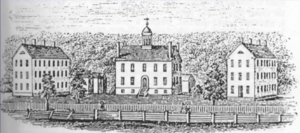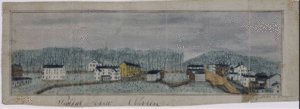Hiram Wilson facts for kids
Hiram Wilson (born September 25, 1803 – died April 16, 1864) was a very important person who fought against slavery. He was known as an abolitionist. He worked directly with people who had escaped slavery in southwestern Ontario, Canada. His goal was to make their lives better and help them fit into society. He did this by offering them education and useful job skills. He even started ten schools just for Black people in southwestern Ontario. Wilson also worked closely with Josiah Henson to create the British-American Institute and the Dawn Settlement in 1841. He traveled to London, England, in 1843 for the World Anti-Slavery Convention. Later, he moved to St. Catharines, Ontario. His home there became a final safe stop for people traveling the Underground Railroad.
Contents
Early Life and Education
Hiram Wilson was born on September 25, 1803, in Acworth, New Hampshire. His parents were Polly McCoy and John Wilson. People said he had a strong desire to help others, a trait common in New England.
Hiram went to the Oneida Institute in upstate New York. At that time, this was the most anti-slavery school in the country. It was a manual labor college, meaning students worked while they studied to help pay for their education.
In 1833, Wilson joined a group of students who left Oneida. They moved to the new Lane Theological Seminary in Cincinnati. However, debates about slavery caused problems at the school and in the city. Wilson left when the school's leaders stopped the Anti-Slavery Society.
Wilson didn't join the debates himself. But he was one of the 72 students, called the Lane Rebels, who left the school. These students demanded the right to discuss important topics. They also wanted students to have freedom of speech. One of the rebels, Theodore Dwight Weld, asked:
But in solemn earnest, I ask, why should not theological students investigate and discuss the sin of slavery?... Is it not the business of theological seminaries to educate the heart, as well as the head?
This quote means he believed students should learn about and discuss important moral issues like slavery.
This group of students then went to the new Oberlin Collegiate Institute. This college took over from Oneida as the most anti-slavery school. Oberlin was very open-minded. It soon welcomed both women and Black students.
Wilson earned a Theology Degree from Oberlin Theological Seminary in 1836. After he graduated, the President of Oberlin, Charles Finney, was interested in the lives of freedom seekers. These were people who had escaped slavery and settled in Upper Canada (which is now Ontario). Finney gave Wilson $25 to travel to Upper Canada. He wanted Wilson to work with the free Black communities there.
Career
Establishing Schools in Canada
When Wilson arrived in Canada, he saw that many free American Black people lived in very poor conditions. They had few chances to get an education and improve their lives. Wilson traveled across the province from fall to spring. Then he returned to the United States. He went as a representative for Upper Canada to a meeting of the American Anti-Slavery Society.
At this meeting, Wilson explained that former enslaved people faced a lot of unfair treatment. He strongly believed that education was key to helping them. Wilson's main goal for Upper Canada was to start schools for Black people. These schools would also be open to anyone who wanted to learn. By 1839, he had started ten schools. Fourteen teachers from Oberlin College came to teach there.
Gerrit Smith from Rochester, New York helped by giving money, clothes, and Bibles for the schools. A Quaker helper named James Canning Fuller from Skaneateles, New York was also very interested in Wilson's progress in Ontario.
British-American Institute
In June 1838, Wilson and Josiah Henson called a meeting of Black Canadians. They wanted to talk about building a school and what subjects should be taught. Henson believed that children should learn basic subjects like those taught in a grammar school. He also thought boys should learn practical skills like carpentry or blacksmithing. Girls, he felt, should learn skills for managing a home.
The Canada Mission Board agreed that Wilson and Henson should find a safe place for freedom seekers. They chose a place called Dawn. Dawn was heavily forested, and its wetlands and grasslands provided animals for the community to eat.
Wilson and Henson bought 200 acres of land near the Sydenham River. This was where they planned to build the school. On December 12, 1841, Hiram Wilson, Josiah Henson, and James Canning Fuller officially started the British-American Institute. This school was a manual labor college within the Dawn settlement. By 1845, there were seventy students. Wilson's first wife, Hannah, taught them.
By the 1850s, most people in Dawn were Black. However, the settlement faced problems. There were disagreements among leaders and money troubles. The Dawn Settlement started to focus too much on the needs of the Institute, instead of the other way around.
In the first few years, about 500 people lived in the Dawn settlement. By spring 1847, Wilson's wife Hannah had passed away, which deeply affected him. By summer 1848, the settlement was deep in debt. Wilson was the only one who still had any credit. He decided to leave because of poor management, bad leadership, and the death of James Canning Fuller. There was never enough money to keep the settlement going and pay off its debts without help from outside.
The idea of a manual labor school seemed good. But the founders didn't find ways to get money and resources for a long time. In 1850, Wilson wrote that the school "ran well for a season, and accomplished much good." But after he left and James Cannings Fuller died, it "has run down, and can hardly be resuscitated again without a miracle."
World Anti-Slavery Convention of 1843
In 1843, Wilson went to the World Anti-Slavery Convention in London, England. He represented the "Central Corresponding Committee for the Coloured Population of Canada." At this meeting, he met with other abolitionists from all over the world. He also toured Britain to raise money. He collected $1100.00 and hundreds of Bibles and Testaments. He met several people who promised to donate to the Dawn settlement.
St. Catharines School and Underground Railroad
After leaving the Dawn Settlement, Wilson moved to St. Catharines, Ontario. There, he worked to create a safe place for freedom seekers. He opened a night school with his second wife, Mary. His first wife, Hannah, had died earlier.
Between 1850 and 1856, they welcomed about 125 refugees into their home. Wilson also started a Sunday school, which he ran until 1861. He gave food, clothing, and Bibles to those who could read. For those who couldn't, he gave spelling books. About 2,000 American Black people arrived in the St. Catharines area between September and December 1850. Another 3,000 arrived from the United States because of the Fugitive Slave Act of 1850. This law made it much harder and more dangerous for freedom seekers.
Wilson's school was a very important stop on the Underground Railroad. Harriet Tubman herself used it for her passengers. When Harriet Tubman arrived in St. Catharines in 1851 with eleven freedom seekers, she met Wilson. They met at the AME Church or the Bethel Chapel. This was the first Black church in St. Catharines.
In 1856, the church's name changed to the British Methodist Episcopal (BME) Church, also known as Salem Chapel. It became the first National Historical site in St. Catharines.
In 1855, Benjamin Drew wrote about Wilson and his family:
...a distinguished, self-denying philanthropist ... With him the refugee finds a welcome and a home; the port stranger is pointed by him to the means of honorable self-support, and from him receives wise counsel and religious instruction...I have seen the Negro- the fugitive slave, wearied with his thousand miles of traveling by night, without suitable shelter meanwhile for rest by day, who had trodden the roughest and most unfrequented ways, fearing, with too much cause, an enemy in every human being who had crossed his path; I have seen such arrive at Mr. Wilson's...I have seen such waited on by Mr. And Mrs. Wilson, fed and clothed, and cheered, and cared for...."
This quote shows how dedicated and helpful Wilson and his wife were to those escaping slavery. Throughout his life, Wilson faced many challenges but kept working for his cause.
Personal Life
Hiram Wilson first married Hannah Maria Hubbard on September 17, 1838, in Troy, New York. Before their marriage, Hannah taught Black children in East Troy, New York. The Reverend Daniel A. Payne described her as a woman with great faith and strong in prayer. He felt she was perfect to be a missionary's wife. Hannah passed away at the home of Josiah Henson in the Dawn settlement.
Wilson lived in St. Catharines with his second wife, Mary A.H. Wilson, and his five children. Their children were John J. Wilson (born 1841), Lydia M. Wilson (born 1843), Mary E. Wilson (born 1845), and George S. Wilson (born 1847). In 1852, he also became the guardian of Alavana Dicken, a former enslaved person.
Hiram Wilson died at his home on April 16, 1864, after having a lung infection. He was buried at Woodland Cemetery in Cleveland, Ohio.



